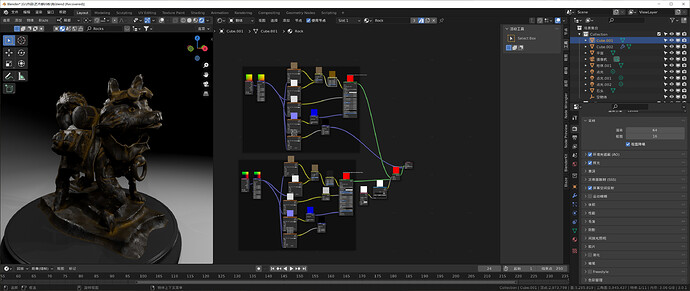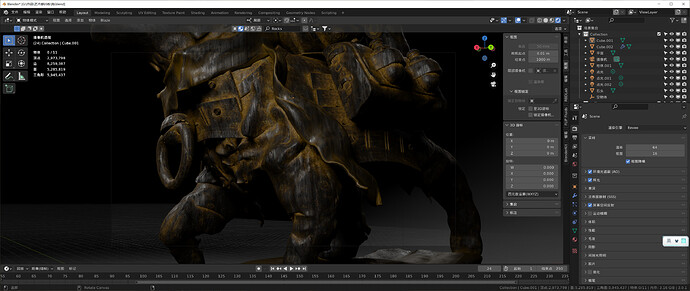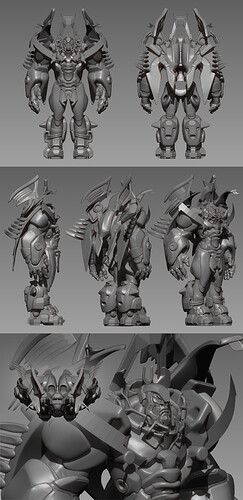Can vulkan support 150-200 million polygon sculpting? 


Hmm, this will limit the progress of sculpt mode, imho…
Sculpt mode should have it’s own set of basic modeling tools, optimized for the sculpting workflow… those tools should even have the freedom to work differently than the ones in edit mode…
Modeling for sculpting is not the same thing as the regular precise mesh editing that is done in edit mode… trying to mix it is not a good thing…
Anyways, that’s up to you… I just hope that such modeling tools will keep showing up, even if available only in the sculpt dev branch…
By the way, I was expecting some words about voxel remesher improvements… 
I agree with you. It is time consuming to extrude in edit mode since it’s too precise. Sculpting offers a faster and more intuitive solution for things. Let extrusion remain in both the modes. They will serve 2 different purposes, one for precise and another for intuitiveness. Blender also needs a proper sculpting workflow with good UX so as to minimise the requirement for switching modes constantly.
Totally agree. Extrude and Inset are two basic features that from my point of view have a place in Sculpt Mode, if you want to use FaceSets to perform Hard Modeling. Although FaceSets can be used to make selections in Edit mode, performance on dense meshes can be an issue.
For the inclusion of Extrude in Sculpt Mode it would be good to investigate why it is needed. So specific use cases and workflow examples where it would help. That could also inspire a Tool that would work better for the sculpting workflow than just adding an Extrude operator.
I agree that switching between modes for a single workflow or task is undesirable. Ideally all necessary functionality should be in a single mode.
Many years ago with ZB, following a tutorial that used contouring with faces from FaceSets, I made this model.
I recently tried to replicate the process with Blender and I showed it in this video.
Thanks for the example! With planned improvements to the expand operator there are also alternative approaches with existing features to achieve this though.
Let me know what you think. It would be good to explore more ways in which an extrude operator would be useful.
Wait, seriously?
Do you really need explanation/examples to know why an extrude tool is useful in sculpt mode?
Please tell me you’re kidding. :
Sculpt mode needs it’s own set of basic modeling tools like extrude, inset, bevel, loop cut, slide.
This would be magnificent. 
But I kinda feel it’s better to keep slide and loop cut to stay in edit mode… because maintaining so many duplicate operations will also become difficult for developers
The fact that Zbrush has all sorts of poly modeling tools added in a brush doesn’t mean that’s the best way to sculpt and model at the same time… I mean, it is definitely more convenient but not “the best” way to do it, it’s just the Zbrush way of doing it, and it makes sense in that case because it’s a sculpting program, not a DCC.
But, IMO things like extrude, inset, bevel, etc are not sculpt operations, those are more precise by nature, which are easier (and offer more control) to do in edit mode. Maybe what we really need is a way to have a seamless switch between sculpt and edit mode, so people don’t feel like is jumping between them.
Think of the bigger picture : once you get all these modeling operations in sculpt mode, what is the place of edit mode ? alternatively, why not add sculpt brushes to edit mode ? all of this functionality does not get in for free, as @USB10 said it adds to the maintenance cost. Mesh and bmesh being different data structures, operators have to be written for both, and if you have the same functionality in both modes, this questions the relevance of both of them -why not design a polyvalent data structure and merge edit and sculpt modes? I don’t really know whether this is possible. Anyway it’s a broader design question than you realize.
Personally I’d retain topology-altering operators in edit mode, because the entire toolset is thought around them. and confine sculpt mode to deformation tools such as brushes, cloth, etc. But maybe I’m not seeing what the possibilities are -what’s the idea with such operators living in sculpt mode? Do you want to build your base meshes entirely from sculpt mode? What is it with edit mode that doesn’t work for you?
@Regnas would you like to try and answer these questions?
Good technique Julien! It could be solved like this too. Anyway, as you have left it, a few Insets in each FaceSet would make the surrounding faces rim all shapes with nice flow. With Remesh or Dyntopo this is lost, but in the meantime there is good mesh flow in the corners.
Personally I don’t see a problem if some modes share similar tools. When sculpting with high density meshes it doesn’t make sense to switch to Edit Mode and convert the selection type.
Similarly, if a retopology mode existed, it would make sense to include Polybuild, while Extrude would not.
In the Sculpt Build Dyntopo keeps the FaceSets and it is a great advantage. A good option would be to add an Auto-Masking in the FaceSet Boundaries with a fade value, to act on the areas where the FaceSet changes or in the interior areas.
Edited:
Perhaps a direct action to make masks on the edges of the FaceSets would give more play. A parameter of thickness and feathering, plus all the modifications that can be made later, would give it more versatility, than an automatic mask.
I doubt that syncing between selection and mask will help a lot.
Most of time creating a mask will be an extra step to select a face set.
And it would create mask from any temporary edit mode selection.
I don’t think that would be a lot more efficient than what we currently have with hidden faces.
IMO, the best option is to create a face set selection mode in edit mode.
Pablo started to create transform operators with masks. And then, he developed face sets because it is more intuitive to work with a selection set and more efficient to have several selection sets stored.
In edit mode, selection sets are vertex groups. Those vertex groups are not always pertinent to store edge loops, face loops or face regions.
Pablo used face sets to create easy face loops and face regions selection sets.
He added a Face Set creation corresponding to face loop with Ctrl W shortcut.
Extrude filter in sculpt mode, is superior to the one in edit mode, by the fact that is automatically creating a new face set.
I think that target to aim is a set of modelling tools adapted to face sets whatever the mode they are in.
And if edit mode could have edge selection sets, too : that would be great.
Keep in mind that the reason why some specialized sculpting programs have traditional editing tools with brushes is because they don’t have an ‘editmode’ to begin with (as they are not full-fledged DCC apps).
I could in fact see the use of enhancing the tooling to make it easier to create hard surface components (which could especially have a use in Dyntopo. An effective reinventing of editmode though would not only steal a lot of time from badly needed core work, but it would also create a complete suite of redundant tools with the additional feature of making it far easier to create an unworkable polygon soup (which means a frustrated sculptor having to tear down large chunks of his model or having to make a new one).
People have complained before that sculpt developers were allegedly focused on the shiny things and not the grunt work that would allow dyntopo to preserve data and perform well or make multires a robust system that can’t break even after mesh editing. Reinventing the wheel of editmode instead will prove to be a penultimate ‘shiny thing’ that did not actually cause a mass movement of professional sculptors to Blender.
To add to this, I think ideally we shouldn’t have modes at all… they only exist for technical reasons and also because there was no “active tool” concept before 2.8x. Ideally we’d get rid of these modes and we’d have brushes live alongside edit mode tools and operators -there is no sensible reason that we should segregate “edit” and “sculpt”. Both are just different ways to edit a mesh object.
Now if we really can’t have those merged for technical reasons, then my take on it is : we should improve edit mode performance rather than duplicate all edit mode operators into sculpt mode.
All of the modes bundled together would open a can of worms though. For instance, how are the devs. going to combine all of the hotkey maps without reintroducing the congested layout and the finger gymnastics of the pre 2.8 days? That is not to mention how each mode has their own custom properties panels and draw modes (so you would somehow need to combine all of those without turning the UI into a labyrinthine button/slider hunt game). The details would obviously be for a different thread though.
Pie menus, of course !
Switching between Sculpt mode and Edit mode has been mentioned.
In edit mode, a more dense mesh in edit mode could be somewhat crowded with overlay stuff …
In vertex selection mode the overlay could consume a big part of object’s shading. From an artists perspective, it is loss of visual information. The visual impact of face selection mode and Edge selection mode is not that strong. It still alters shading on a more dense mesh. But, eyes do need shadings as a visual feedback about the shape.
If there is a plan to establish a workflow between Sculpting and Edit mode, it might work for less dense meshes.
But something still confuses me. If an artist works with more dense stuff, how to limit this kind of overlay overload in edit mode?
( Switching off overlay would not do the job, because there would not be a feedback about what is being selected. )





